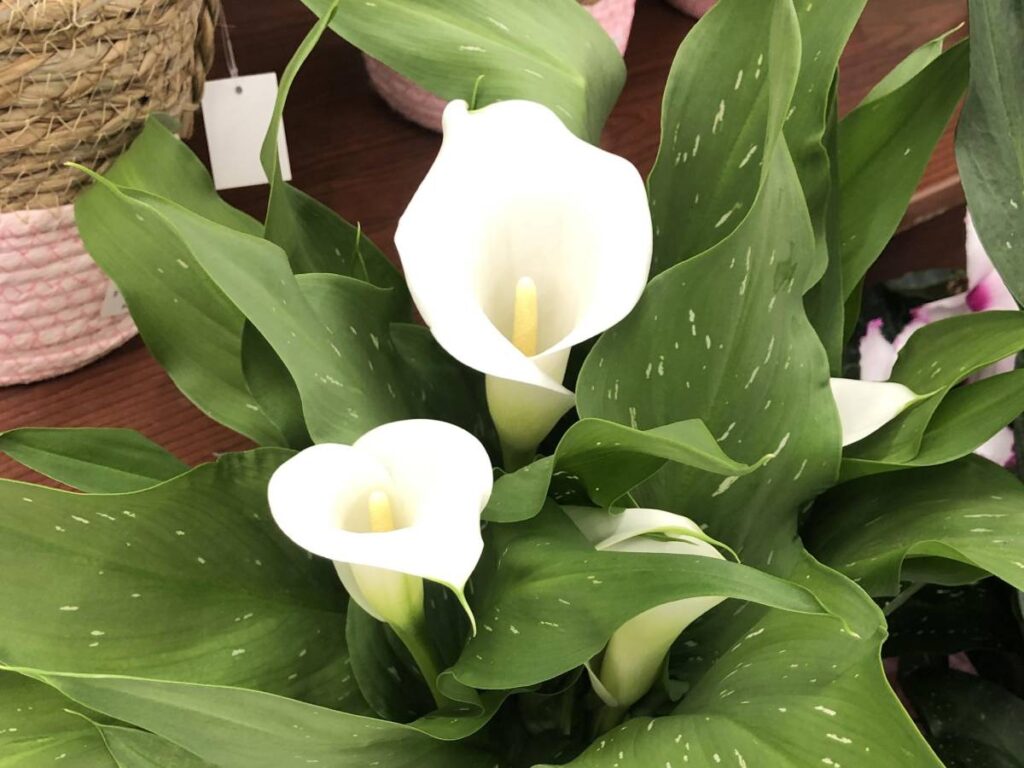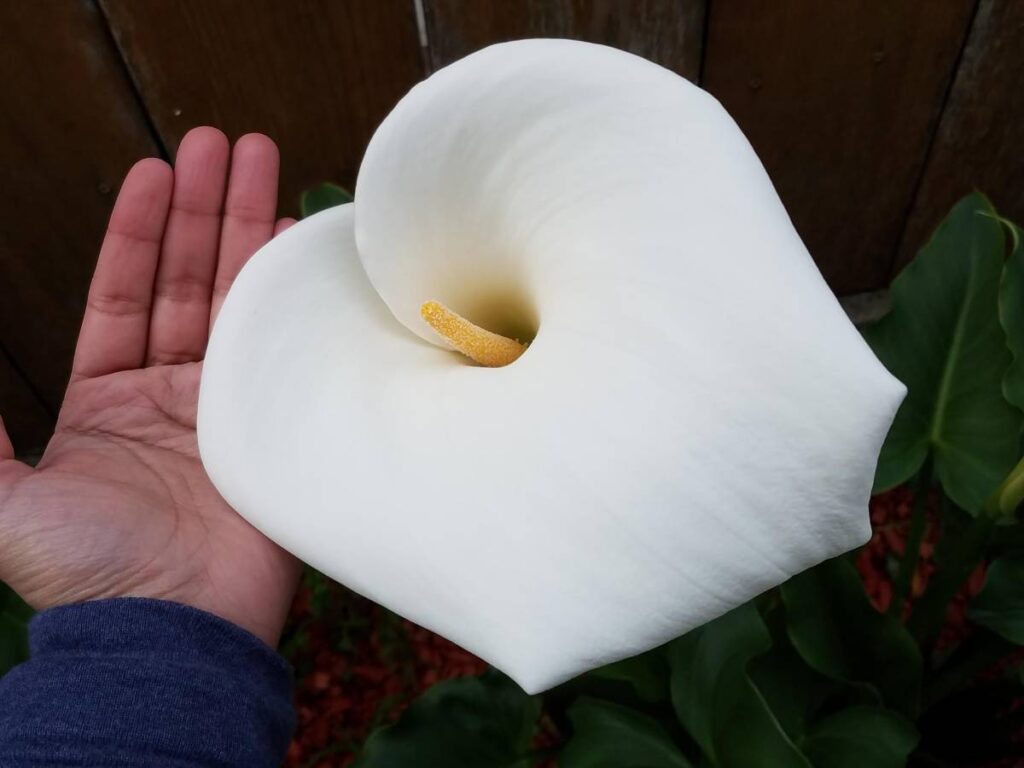The beauty of a calla lily is undeniable. Its elegant white petals and graceful shape make it an eye-catching addition to any garden.
But can these delicate flowers survive in the outdoors? This question has been asked by many gardeners, both novices and experienced alike.
In this article, we will learn how to plant and care for this beautiful flower for outdoor gardening. With easy-to-follow instructions, you’ll have a stunning garden in no time!
Here’s Can Calla Lilies Be Planted Outside
Calla lilies can be planted outside in moist, well-drained soil that is rich in organic matter. Protect them from frost. They prefer full sun to partial shade and will do best in an area that receives at least six hours of direct sunlight each day.

Calla Lily Growing and Care Instructions If Planted Outside
1. Choosing the right location for your calla lilies
The location of your calla lilies is key to their success when planted outside. Calla lilies come from South Africa, where they have adapted to living in warm, humid places with soil that drains well.
To recreate their ideal environment elsewhere, you need to consider both the amount and type of sunlight the location receives, as well as the drainage of the soil.
Look for an area that receives at least six hours of full sun each day, as this will allow the calla lilies to thrive. The soil should also drain well so that standing water doesn’t hurt the roots of the calla lilies.
If your soil tends to be heavy or clay-like, it is important to take action by adding organic matter or installing a drainage system in order for them to flourish.
If you live in a region with cold winters, it is important to select a spot that is not prone to frost or use frost blankets on cold nights in order to protect your plants from freezing temperatures.
2. Preparing the soil for calla lilies
If the calla lily is planted outside, it should be planted in a sunny to partially shaded site with amended, well-drained soil. The soil should be rich in nutrients such as nitrogen, phosphorus, and potassium.
Also, it should have organic matter like compost or peat moss to help the soil drain better and be more fertile. The pH level of the soil should be between 5.5 and 6.5 for optimal plant growth.
3. Light requirements
If the calla lily is planted outside, it requires full sun to partial shade and bright, indirect light. It should not be planted in dense shade or exposed to scorching midday summer sun.
You should choose a sunny or partially shaded site. If possible, protect plants from strong winds that could cause them damage or blow away their flowers before they have fully bloomed.
Prune dead flowers regularly so they do not distract from the new blooms forming later in the season.
4. Planting instructions
Planting calla lilies outside is a great way to bring color and life to your garden or outdoor area. Before you do, however, it’s important that you bear in mind some key planting instructions.
- Firstly, before planting your calla Lily, apply a slow-release fertilizer to the soil. it’s best to plant calla lilies in moist, well-draining soil that contains plenty of organic matter – such as compost or well-rotted manure.
- Secondly, make sure you dig a hole which is big enough for the bulb itself and around 6 inches deep before placing the plant with the pointed side facing down. You should also leave 18 inches of space between each flower to give them ample room to grow!
- Once planted, mulch around the area in order to retain moisture and suppress weeds.
- Finally, don’t forget to water them thoroughly after planting and keep an eye out for dry spells – they need regular watering in order for their beautiful blooms to flourish!
5. Watering instructions
– Check the soil to see if it is slightly dry. If it is, water the calla lily plant with enough water to moisten the soil.
– Do not overwater or drown the plant, as this can cause root rot and kill your calla lily plant quickly.
– Apply a balanced liquid fertilizer every two weeks while they’re blooming, or as directed on the product label, to your calla lily plant outside in your garden or landscape area for optimal growth and flowering ability.
For example, you should water a calla lily planted outside once the soil has dried out slightly, and then continue to do so every few days until it gets rain again, or until you apply fertilizer again in two weeks as directed by the product label instructions for the best results in growing healthy plants that produce beautiful blooms year after year!
6. Fertilization
Once the plant is in the ground, don’t add any more nitrogen to the soil. Doing so will make the plant grow a lot of leaves and long stems, which will stop it from making buds.
Water regularly until the flower stalks start shooting up, around eight weeks after planting, and then continue watering every couple of days until blooming season is over (around two months).
For example, you could use a fertilizer with an N-P-K ratio of 13-5-10 or 15-5-10 for optimal results when fertilizing your calla lilies planted outside. Additionally, you should water at least once every couple of days during flowering season to ensure that the plant stays hydrated throughout this period of time—especially if it’s hot out!
7. Pest control
1. Check your calla lily often for signs of pests or disease, like leaves that are wilting or spots of different colors on the leaves.
2. If you spot any signs of pests or disease, remove and destroy the infected parts of the plant immediately to prevent further spread.
3. Spray an insecticide directly on the bugs and around the base of your calla lilies to quickly and effectively get rid of aphids and other garden pests.
4. If slugs are present in large numbers, use a bait that contains iron phosphate, as it is effective against them but not harmful to humans or other wildlife creatures if ingested accidentally by them while eating it off their food sources (they eat anything).
5. Spider mites are a common pest of calla lilies, so use an insecticidal soap spray designed specifically for them.
Follow the directions on the label of the product you’re using. This will make sure that the soapy solution you spray on the plants in your outdoor garden plot works well and keeps you safe.
8. Maintenance tips
1. Water your calla lilies regularly, about once a week.
2. Keep the soil around the plant moist but not soggy, and add mulch if necessary to help with drainage and prevent weeds from growing around it.
3. Apply fertilizer every few months according to the directions on the package for the best results with flowering and the plant’s overall growth.
4. Prune off any dead or wilted leaves and flower stalks to encourage new growth and blooms and keep it looking healthy and attractive in its surrounding area or garden bed you have planted it in.
5. Inspect your calla lily regularly for signs of pests or disease, such as wilting leaves or discolored spots on the foliage, and take action if necessary.
Remove any leaves that have been infested by pests like aphids or scale insects so they don’t spread further across your entire garden area.
Example: If you notice aphids on your Calla Lily leaves, remove them with a soft cloth dipped in soapy water. Then, spray the plant with insecticidal soap that has been diluted according to the directions on the package. After two weeks, add more fertilizer.
9. Safety concerns
When growing or caring for a calla lily outside, safety concerns should be taken into account, including:
• Avoiding direct sunlight, which can burn the plant’s leaves.
• Watering only when the soil is dry to prevent root rot and stem decay.
• Removing any dead or decaying foliage to reduce the risk of attracting insects or pests.
• Providing ample airflow around the plant to help prevent fungal growth and rot issues.
• Identifying any potential threats such as rabbits, deer, insects, or other animals that may pose a threat to the plant’s well-being.
What Are the Steps on How to Plant a Calla Lily Outside?
First, you will need to purchase the bulbs at the appropriate time, usually late fall or early winter. You’ll want to keep them in a cool, dormant place like a basement or garage until spring arrives.
When it’s time to plant them, treat your calla lilies as you would any other bulb or tuber. Plant the bulb so that the part where it bulges out is just covered by soil, and spread mulch around its base to help keep the soil moist and drain water away from the root system.
When planting calla lilies outdoors, it is important to be aware of the danger of frost. Planting too early in the season can result in frost damage to the bulbs, so it is best to wait until all danger of frost has passed before planting. I recommend planting in the spring.
Once spring starts, wait for your calla lilies to bloom outside. During this time, try cutting back to about 6 inches above ground level, as this will force your plant to focus all its energy on developing its root system and creating larger bulbs for better blooms!
Additionally, make sure you’re giving your lilies sufficient water during their growing season and feed them with balanced flowering fertilizer once a month or twice a month, depending on the conditions outdoors.

What Are the Benefits of Planting Calla Lily Outside?
Calla lilies are not frost-tolerant plants, they are often grown indoors. However, there are still some benefits to growing calla lilies outdoors, which are outlined below:
Bright, colorful flowers: Calla lilies are known for their bright, colorful flowers that come in a range of hues, including white, yellow, pink, purple, and red. These flowers are a beautiful addition to any outdoor space and can add a pop of color to your garden.
Easy to care for: Calla lilies are relatively easy to care for and do not require a lot of maintenance. They like soil that drains well and is watered regularly. They can grow in a variety of climates and soil types.
Long blooming season: Calla lilies typically bloom from late spring to early fall, providing a long season of color in the garden. Deadheading spent flowers can help extend the blooming season even further.
Attracts pollinators: Calla lilies are attractive to pollinators such as bees and butterflies, which can help promote the health of your garden ecosystem.
Versatility: Calla lilies can be grown in a range of garden settings, including borders, beds, and containers. They can also be grown in a range of climates and soil types, making them a versatile choice for outdoor gardening.
Can Calla Lilies Be Grown Outdoors in Non-Native Regions?
The natural habitat of calla lilies
Calla lilies are native to Southern Africa, and as such, they naturally call warm climates home. These beautiful blooms grow best between 55°F and 65°F, although they can tolerate temperatures up to 75°F.
Unfortunately, cold winters in non-native regions can spell disaster for these flowers, so if you plan on growing them outdoors, it’s important to understand that they may be damaged or even killed by frost.
That being said, with the right care and attention, those living in colder climates can still manage to cultivate their own outdoor garden of calla lilies—a stunning reminder of their natural home!
Growing calla lilies outdoors in non-native regions
Before you begin, it’s important to determine if these flowers will do well in your area—especially if you live in a non-native region.
Lucky for us, calla lilies can be grown outside of their natural habitat as long as certain things are taken into account.
Calla lilies prefer warm and humid climates, so if the temperatures tend to be very cold or dry where you live, you may need to find a way to provide additional protection or grow them in containers that can be moved indoors when necessary.
You’ll also have to make sure the soil has adequate drainage; clay-like soils won’t do well for calla lilies, which need well-aerated loam with plenty of organic matter.
Finally, make sure the plants get at least 6 hours of direct sunlight daily; planting them in an area with partial shade can help limit their exposure to frost.
Considerations for Planting Calla Lilies Outdoors
When planting calla lilies outdoors, there are several things to consider if you want them to thrive.
First off, calla lilies come from South Africa and prefer warm, humid climates with well-draining soil in order to thrive. So if you live in a region with extreme temperatures, you may need extra protection or the ability to move your plants indoors during those times.
Secondly, it’s important to think about the soil and make sure it’s well-draining and rich in organic matter; if not, you may need to amend it or add drainage systems.
Lastly, calla lilies need at least six hours of direct sunlight each day, so be sure to choose a location that offers full sun or partial shade—you might even need to provide some frost protection for them.
Alternatives to PlantingCalla Lilies Outside
If outdoor conditions are not suitable for planting calla lilies, don’t worry—there are some great alternatives!
Container gardening is one option that enables you to bring your calla lilies indoors or to a protected location, while still growing and caring for them naturally.
Choose a container with holes for drainage, and use soil made for container plants that drains well. Water regularly and fertilize as needed.
You could also grow your calla lilies as houseplants in a sunny location and provide bright, indirect light. Water regularly but allow the soil to dry out slightly between watering, and fertilize every two to four weeks during the growing season.
For those who live in locations with mild climates, greenhouse gardening may also be an option. Keep the temperature and humidity levels consistent and provide plenty of sunlight and water so your plants can thrive all year.
Regardless of where you’re located, you can find an alternative way to enjoy lush, colorful calla lilies!
Conclusion
Calla lilies are a beautiful addition to any garden, but they must be planted and cared for properly in order to thrive. With a little knowledge and effort, you can enjoy these lovely flowers in your outdoor garden for many years to come.
Source:
How to Plant a Purple Calla Lily Outside







